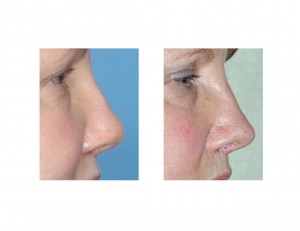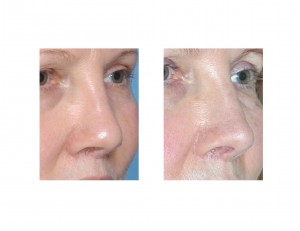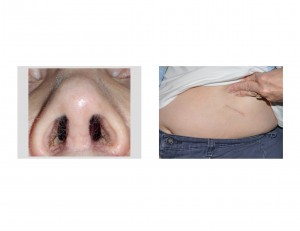Background: The evolution of rhinoplasty surgery over the past twenty years has leaned heavily towards a cartilage preservation approach. Focus has been more on cartilage reshaping and less on cartilage removal. As a result, the once common over-reduced or ‘ski-slope’ nose is now a rare finding rather than a common one. When an over-reduced nose presents, the concept of nasal lengthening or expansion is needed for secondary revision.
Case Study: This is a case of a 56 year-old female who came in having had three prior rhinoplasty procedures. Her primary rhinoplasty appeared to have been for reduction of a hump and narrowing and shortening of the nasal tip. Apparently the primary rhinoplasty created a reverse problem, that of a saddle nose deformity and a retracted shortened tip with excessive nostril exposure. Her original surgeon performed two subsequent revisions, using septal and both ear cartilages for donor sites during the two procedures. While improvement was clearly obtained, she was still unhappy with the shortened tip and nostril exposure. Her original surgeon informed her that she had no more cartilage to give and she sought other opinions.


The two undesired aspects of rib harvesting, pain and scar, can be controlled by surgical technique. Injecting with a long-acting local anesthetic keeps the discomfort at bay at least for the first 24 hours after surgery. Waking up with severe rib pain can be avoided. The incision for rib graft harvesting can be kept quite small. The skin slides freely over the ribcage so there is no need to make a long incision.

Case Highlights:
1) The success of revisional rhinoplasty is often dependent on adequate cartilage grafts. Recovery from prior rhinoplasty procedures in the over-reduced nose requires cartilage restoration for soft tissue expansion and lengthening.
2) Cartilage graft harvesting from the rib always provides an adequate amount of cartilage. While there is more discomfort from the harvest site, its use should always be considered when septal and ear grafts have been previously harvested. The scar is usually cosmetically acceptable.
3) The need for a second or third rhinoplasty revision is rare and can be overcome with a commitment to full exposure and cartilage grafting.
Dr. Barry Eppley
Indianapolis, Indiana


